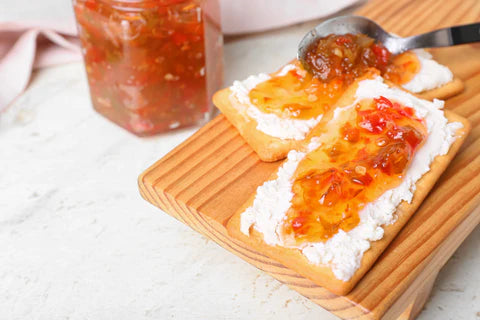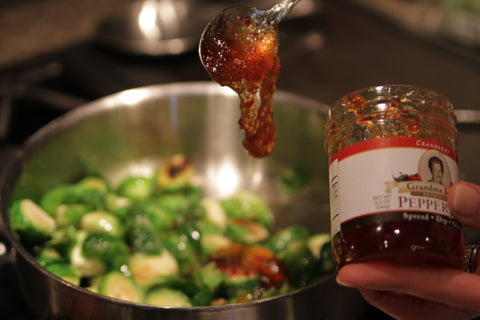
Pepper Jelly Traditions: A Look at the History and Cultural Significance of Spicy Jellies
Share
Introduction
Pepper jelly, a delicious blend of sweet and spicy flavors, has a rich history and cultural significance in various cuisines around the world. This versatile condiment has evolved over time, with unique variations and uses emerging in different regions. In this comprehensive blog article, we will explore the origins of pepper jelly, its cultural significance, and how it has been adapted and enjoyed throughout history.

I. The Origins of Pepper Jelly
A. The discovery of peppers
- Peppers are native to Central and South America and have been cultivated for thousands of years.
- Christopher Columbus encountered these spicy fruits during his travels and brought them back to Europe, where they quickly spread to other parts of the world.

B. The evolution of pepper jelly
- As peppers became a staple ingredient in various cuisines, inventive cooks experimented with new ways to enjoy their flavors.
- Combining peppers with sugar and vinegar, early versions of pepper jelly likely emerged as a way to preserve the spicy harvest and enjoy its flavors throughout the year.

II. Cultural Significance of Pepper Jelly Around the World
A. Southern United States
- In the Southern United States, pepper jelly became a popular condiment, particularly in states such as Louisiana and Texas.
- The region's diverse culinary influences, including French, Spanish, and African, contributed to the development of unique pepper jelly recipes.
- Southern pepper jelly is often served with cream cheese and crackers as a simple appetizer or snack.

B. Caribbean cuisine
- The Caribbean is home to a wide variety of peppers, and pepper jelly is a staple condiment in many island nations.
- Caribbean pepper jellies often incorporate regional flavors, such as tropical fruits, rum, or spices, for a distinctive twist.
- This spicy jelly is commonly used as a glaze for grilled meats or served with rice and peas.

Caribbean Mango Pepper Jelly Salmon (Grandma Jones' Originals)
TIP: Use pepper jelly as a spread, dip, or glaze on your favorite meats, poultry, or fish! Mango pairs fabulously with fish or chicken!
C. Southeast Asian cuisine
- Southeast Asian countries, such as Thailand and Vietnam, are known for their love of spicy flavors, and pepper jelly has found a place in these cuisines.
- Local variations may include ingredients like fish sauce, lemongrass, or ginger for a uniquely Southeast Asian spin on the classic condiment.
- In these regions, pepper jelly is often used as a dipping sauce for spring rolls, grilled meats, or as a topping for rice dishes.

III. Modern Adaptations and Variations of Pepper Jelly
A. Fusion cuisine
- As global culinary trends continue to evolve, chefs and home cooks alike are experimenting with new ways to incorporate pepper jelly into their dishes.
- Fusion cuisine often blends the flavors of different cultures, resulting in inventive pepper jelly creations that showcase diverse ingredients and techniques.

B. Dietary adaptations
- As more people adopt specialized diets, such as vegan or gluten-free, there has been a growing demand for pepper jelly recipes that cater to these preferences.
- Modern recipes may use alternative sweeteners, such as agave or coconut sugar, to accommodate those with dietary restrictions or health concerns.
Conclusion
Pepper jelly has a rich history and cultural significance in various regions around the world. From its origins in Central and South America to its modern adaptations and variations, this sweet and spicy condiment has captivated the taste buds of countless food lovers. The unique recipes and uses of pepper jelly in different cuisines showcase the versatility and adaptability of this flavorful condiment.

Glaze your favorite meat with pepper jelly for added sweet and spice
IV. Pepper Jelly in Contemporary Culinary Culture
A. Gourmet pepper jelly brands
- Today, there are numerous gourmet brands producing high-quality pepper jellies, often using locally-sourced ingredients and traditional recipes.
- These artisanal products offer a wide variety of flavors and heat levels, catering to the diverse tastes and preferences of pepper jelly enthusiasts.

Grandma Jones' Originals Pepper Jelly
B. Homemade pepper jelly
- The art of making homemade pepper jelly has been passed down through generations, with many families cherishing their unique recipes and techniques.
- Home cooks continue to experiment with new flavors and ingredients, creating innovative pepper jelly variations that reflect their personal tastes and culinary creativity.

C. Pepper jelly in popular culture
- Pepper jelly has also made its way into popular culture, appearing in TV shows, movies, and food festivals.
- This increased visibility has introduced even more people to the world of pepper jelly, inspiring a new generation of enthusiasts to explore the diverse flavors and culinary applications of this delightful condiment.
Conclusion
Pepper jelly's rich history and cultural significance have contributed to its widespread popularity and enduring appeal. As the culinary world continues to evolve, this versatile condiment will undoubtedly remain a beloved favorite, inspiring creativity and connecting people through the shared experience of delicious food. Whether enjoyed in traditional recipes, contemporary fusion dishes, or inventive culinary creations, the sweet heat of pepper jelly promises to delight palates for generations to come.
